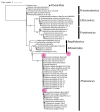Phaeoviruses Present in Cultured and Natural Kelp Species, Saccharina latissima and Laminaria hyperborea (Phaeophyceae, Laminariales) , in Norway
- PMID: 38140573
- PMCID: PMC10747701
- DOI: 10.3390/v15122331
Phaeoviruses Present in Cultured and Natural Kelp Species, Saccharina latissima and Laminaria hyperborea (Phaeophyceae, Laminariales) , in Norway
Abstract
Phaeoviruses (Phycodnaviridae) are large icosahedral viruses in the phylum Nucleocytoviricota with dsDNA genomes ranging from 160 to 560 kb, infecting multicellular brown algae (Phaeophyceae). The phaeoviral host range is broader than expected, not only infecting algae from the Ectocarpales but also from the Laminariales order. However, despite phaeoviral infections being reported globally, Norwegian kelp species have not been screened. A molecular analysis of cultured and wild samples of two economically important kelp species in Norway (Saccharina latissima and Laminaria hyperborea) revealed that phaeoviruses are recurrently present along the Norwegian coast. We found the viral prevalence in S. latissima to be significantly higher at the present time compared to four years ago. We also observed regional differences within older samples, in which infections were significantly lower in northern areas than in the south or the fjords. Moreover, up to three different viral sequences were found in the same algal individual, one of which does not belong to the Phaeovirus genus and has never been reported before. This master variant therefore represents a putative new member of an unclassified phycodnavirus genus.
Keywords: MCP; Nucleocytoviricota; Phycodnaviridae; kelp; phaeovirus; phylogeny; prevalence.
Conflict of interest statement
The authors declare no conflict of interest.
Figures





References
-
- Wilson W.H., Allen M.J. Viruses of Eukaryotic Algae. In: Hurst C.J., editor. Studies in Viral Ecology. John Wiley & Sons, Inc.; Hoboken, NJ, USA: 2011. pp. 189–203.
-
- Müller D.G., Parodi E. Transfer of a Marine DNA Virus from Ectocarpus to Feldmannia (Ectocarpales, Phaeophyceae): Aberrant Symptoms and Restitution of the Host. Protoplasma. 1993;175:121–125. doi: 10.1007/BF01385009. - DOI
-
- Müller D.G., Brautigam M., Kntppers R., Muller D.G. Virus Infection and Persistence of Foreign DNA in the Marine Brown Alga Feldmannia Simplex (Ectocarpales, Phaeophyceae) Phycologia. 1996;35:61–63. doi: 10.2216/i0031-8884-35-1-61.1. - DOI
MeSH terms
Supplementary concepts
Grants and funding
LinkOut - more resources
Full Text Sources
Miscellaneous

